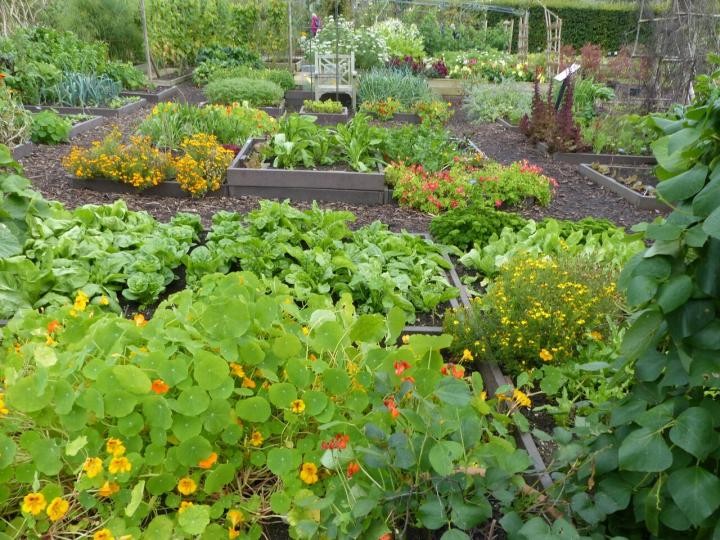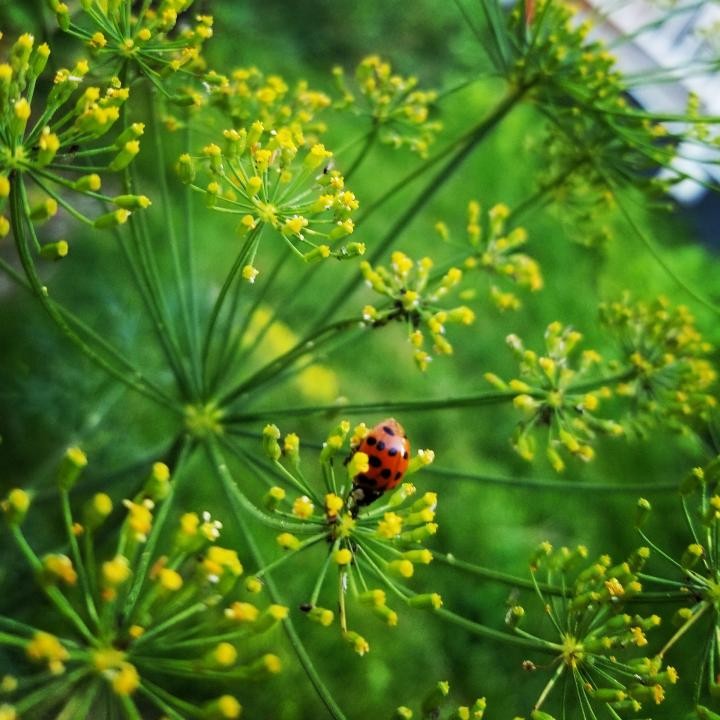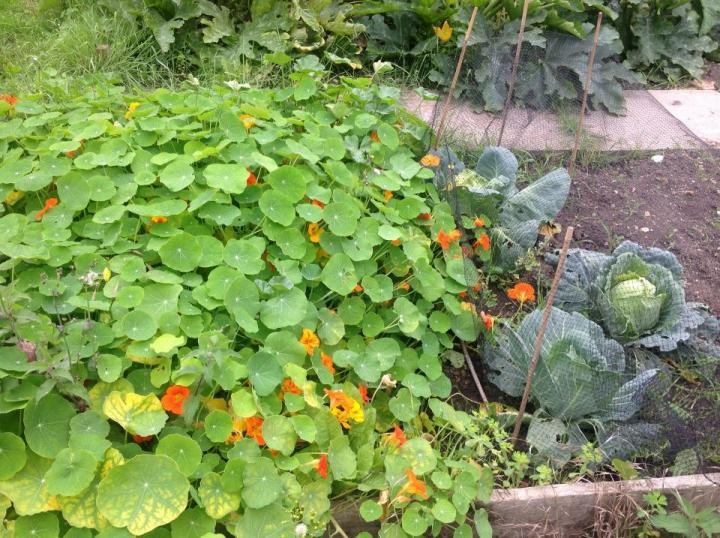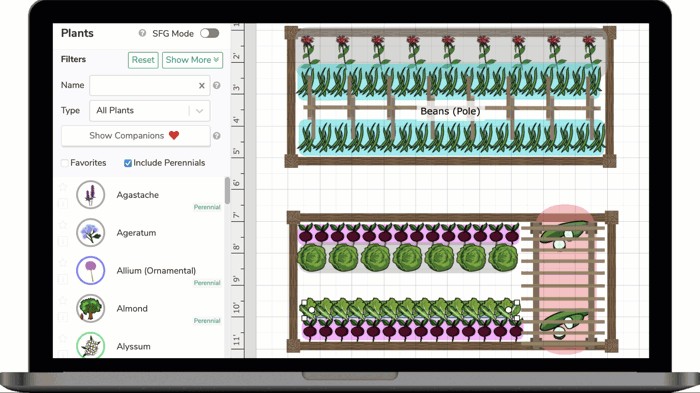Companion Gardening Guide is your roadmap to creating a thriving and harmonious garden ecosystem. At CONDUCT.EDU.VN, we understand the complexities of gardening, and we’re here to provide you with a comprehensive guide that unlocks the secrets to successful companion planting. Discover time-tested strategies for pest control, pollination enhancement, and overall plant health to improve crop yield and promote sustainable growth with companion planting ideas.
1. Understanding Companion Planting: Nature’s Symbiotic Relationships
Companion planting involves strategically placing different plants together to benefit one another within a shared ecosystem. This practice nurtures a community in which fruits, vegetables, herbs, and flowers collaborate to enhance each other’s resilience and productivity. Benefits range from simple support, such as nectar-rich flowers attracting pollinators to fruiting crops like tomatoes, to complex reciprocal relationships like the “Three Sisters” (corn, beans, and squash) which mutually benefit each other.
By intentionally cultivating communities of compatible plants, gardeners can minimize pest damage, boost soil fertility, reduce weed competition, and ultimately achieve higher yields. Gardens thoughtfully designed with companion planting techniques are not only more productive but also aesthetically pleasing, reflecting nature’s harmonious balance.
2. Proven Benefits of Companion Planting Techniques
Companion planting offers a range of advantages, making it an essential practice for gardeners looking to optimize their yields and promote ecological balance. These benefits include:
-
Deterring Pests: One of the most significant challenges for gardeners is managing pests. While chemical pesticides can offer immediate relief, they often harm beneficial insects and disrupt the ecosystem. Companion planting provides a natural alternative by using plants with pest-repellent properties. Planting single crops in large blocks makes it easier for pests to locate and attack them. Intermingling crops can confuse pests, making it harder for them to find their preferred hosts. This strategy is supported by extensive evidence showing that diverse plantings reduce pest infestations, promoting healthier growth and increased yields.
-
Attracting Beneficial Insects: Some plants attract beneficial insects that prey on garden pests. For example, borage attracts pollinating bees and tiny pest-eating wasps. Beneficial insect-attracting plants have received the thumbs-up from researchers, validating the efforts of gardeners who plant “pollinator strips” (rows of pollinator-magnet plants) within the garden to encourage pollinators and pest predators.
-
Shade Regulation: Larger plants can provide necessary shade for smaller, sun-sensitive plants. For example, planting corn alongside lettuce can protect the lettuce from intense sunlight, preventing bolting and extending its growing season.
-
Natural Supports: Tall, sturdy plants like corn and sunflowers can support lower-growing, sprawling crops such as cucumbers and peas. This eliminates the need for artificial supports and maximizes space utilization.
-
Improved Plant Health: Certain plants can alter the soil biochemistry to benefit nearby plants. These interactions enhance nutrient availability and uptake, leading to healthier and more vigorous growth.
-
Improving Soil Fertility: Legumes like beans and peas fix nitrogen in the soil, making it available for other plants. Plants with long taproots, like burdock, bring up nutrients from deep in the soil, enriching the topsoil to the benefit of shallow-rooted plants.
-
Weed Suppression: Planting sprawling crops like potatoes with tall, upright plants minimizes open areas where weeds typically take hold. This reduces weed competition and the need for manual weeding.
A thriving vegetable garden employing companion planting and raised beds.
3. The Science Behind Successful Companion Planting: Evidence-Based Strategies
Companion planting’s effectiveness has moved beyond traditional lore, with increasing scientific research validating its benefits. This research confirms that strategic plant pairings can significantly reduce pests, boost growth, and support wildlife.
-
Traditionally, gardeners believed that vegetables had “friends” and “foes”—companion plants that either benefitted or impeded growth. Although not entirely incorrect, research indicates that most plant associations are positive. “Bad” combinations are rare, with the exception of plants like black walnut trees, which secrete growth inhibitors. The focus now is on identifying and leveraging “good” companion plants to maximize garden productivity.
-
Misconceptions about companion planting abound online, often based on folklore or hearsay. While personal observations are valuable, it’s essential to rely on scientific evidence and proven practices. This approach ensures that companion planting strategies are effective and reliable.
-
Companion planting traditionally focused on vegetable pairings. We’ve expanded our chart to include more flowers, which act as natural insect repellents and attract pollinators. Nasturtiums, for instance, are excellent at drawing pests away from vulnerable crops. Nectar-rich flowers like zinnias, comfrey, and ageratum attract bees and other pollinators, enhancing the pollination of flowering crops like tomatoes, beans, and squash.
4. Examples of Highly Effective Companion Plants and How to Use Them
Here are some of the best companion planting combinations to incorporate into your garden:
- Basil and Tomatoes: Basil repels thrips and disorients moths that lay eggs for tomato hornworms and armyworms. Basil also attracts bees, improving pollination, tomato health, and flavor.
- Dill and Various Plants: Dill attracts ladybugs, which prey on aphids and spider mites. Dill also serves as a food source for caterpillars and butterflies, supporting biodiversity.
- Borage and Strawberries/Tomatoes: Borage attracts pollinating bees, benefiting both tomatoes and strawberries. It also enhances the flavor and vigor of strawberries.
- Garlic and Potatoes/Cabbages: Garlic’s strong scent deters many insects, including aphids, onion flies, ermine moths, and Japanese beetles. Plant garlic between rows of potatoes, alongside lettuces and cabbages, and near fruit trees.
- Mint and Various Plants: Mint deters aphids, ants, and flea beetles. Due to its aggressive growth, plant mint in its own pot or bed to prevent it from taking over.
- Nasturtiums and Brassicas/Fava Beans: Nasturtiums attract caterpillars away from brassicas like cabbage, broccoli, and kale. They also lure black flies away from fava beans.
- Parsley and Tomatoes: Parsley attracts beneficial insects to protect and pollinate tomatoes. Plant parsley between tomato plants for best results.
- Poached Egg Plants and Lettuce: Poached egg plants attract hoverflies, which control aphids on nearby lettuce.
- Sage and Carrots/Cabbages: Sage repels carrot flies and cabbage moths, protecting these crops from damage.
- Sunflowers and Cucumbers/Pole Beans: Sunflowers provide support for climbing plants like cucumbers and pole beans and offer shade to crops susceptible to sun stress.
- Tansy and Various Plants: Tansy attracts pest-eating bugs like ladybugs and predatory wasps while repelling cutworms and other pests.
Dill attracts beneficial ladybugs, which effectively control aphids.
Growing calendula or cosmos attracts tiny parasitizing wasps and aphid-hungry hoverflies. Marigolds are also excellent for drawing in beneficial bugs that feed on pests.
5. The Science-Backed Plant-Insect Relationships in Companion Planting
Many studies have investigated specific plant-insect relationships, providing a scientific basis for companion planting practices.
- Researchers at the University of Nebraska found that radishes planted with pumpkins repel squash bugs.
- Nasturtiums grown around fruit trees deter pests like codling moths by secreting water-soluble glucosinolates, which the trees absorb, gaining defensive superpowers.
- Brassica family plants, including mustards, horseradish, cabbage, and kale, also use glucosinolates to defend against pests.
- Some companion combinations work by masking the presence of one plant from pests, such as the tomato and basil pairing.
- A study by the University of Nice Sophia Antipolis in France showed that basil reduces tomato pests by disguising the tomatoes from thrips, carriers of the tomato spotted wilt virus.
- Scientists at Iowa State found that thyme, used as a living mulch, confuses armyworm moths, reducing egg-laying on tomatoes.
- Flowers rich in nectar attract pollinators and beneficial insects that prey on garden pests.
- Hoverflies are drawn to poached egg plants and feed on aphids, reducing aphid populations on nearby lettuce.
- Borage attracts tiny wasps that parasitize tomato hornworm caterpillars, providing both pollination and pest control.
- A study by the Kentucky Academy of Science found that dwarf sunflowers attract ladybugs to control corn pests.
- Researchers at Rutgers University have shown that dill attracts parasitic wasps to control cabbage worms and loopers and lures enemies of the Colorado potato beetle.
6. Detailed Companion Planting Chart: 20 Common Vegetables and Their Best Companions
The following chart provides a comprehensive guide to companion planting, listing 20 common garden crops and their ideal companion plants. This information will help you create a harmonious and productive garden.
Companion Planting Chart
| Crop Name | Companions | Benefits and Notes |
|---|---|---|
| ASPARAGUS | Calendula, Petunias, Tomatoes | Calendula, tomatoes, and petunias deter asparagus beetles. |
| BASIL | Peppers, Purslane, Tomatoes | Purslane shades the soil around basil plants, keeping them fresh in hot weather. Basil improves the growth and flavor of tomatoes and peppers. |
| BEANS | Beets, Corn, Lovage, Nasturtium, Rosemary, Squash, Strawberries, Sunflower | Nasturtiums entice aphids away from beans. Lovage and rosemary have insect-repellent qualities. Sunflowers provide shade. Corn benefits from the beans’ nitrogen-fixing capabilities, and pole beans provide structural support. |
| BEETS | Brassicas, Bush beans, Garlic, Lettuce, Onion family | Beets are companions for chicory and endive. Onions protect against borers and cutworms. Beet leaves add minerals to the soil (25% magnesium). |
| BROCCOLI | Oregano, Other Brassicas (Cabbage, brussels sprouts, cauliflower, etc.) | Oregano has insecticidal properties. Plant Brassicas together to cover with nets for pest protection. They also prefer lime in the soil. |
| CABBAGE | Garlic, Nasturtium, Sage | Nasturtiums deter insect pests like beetles and aphids. Garlic repels insects with its odor. Sage deters cabbage moths. |
| CARROTS | Chives, Leeks, Onions, Peas, Radishes, Rosemary, Sage | Chives improve the growth and flavor of carrots and deter aphids, mites, and flies. Rosemary and sage repel the carrot fly. Leeks repel many flying pests, including carrot rust fly. Foes: Dill can reduce the yield of carrots. Carrot family members should not be planted near carrots (they tend to cross-pollinate). |
| CORN | Beans (pole), Cucumbers, Dill, Melons, Peas, Squash, Sunflower | Dill protects against aphids and mites. Beans provide nitrogen. Sunflowers act as a structure and windbreak; dwarf sunflowers attract ladybugs to control aphids. Pole beans add nitrogen and provide structural support. Spinach grows well in the shade of corn. |
| CUCUMBERS | Beans, Borage, Dill, Lettuce, Nasturtiums, Oregano, Radish, Sunflowers, Tansy | Dill protects against aphids and mites. Nasturtium deters aphids, beetles, and bugs and improves growth and flavor. Oregano deters pests. Radish, Nasturtium, and Tansy repel cucumber beetles. Tansy deters ants, beetles, bugs, and flying insects; borage improves flavor and growth. |
| LETTUCE | Chives, Onions, Oregano, Peas, Poached Egg plants, Radishes, Scallions, Zinnia | Chives, onions, and garlic deter aphids and other pests by masking the scent of lettuce. Basil improves flavor and growth. Radishes act as a trap crop for flea beetles. Poached egg plants attract hoverflies and other beneficials that eat aphids. |
| ONIONS | Beets, Cabbage, Carrot, Chard, Lettuce, Strawberry, Tomatoes | Onions protect against borers and cutworms. Their aroma disorients pests. Marigolds reduce egg laying by onion maggot flies. |
| PEAS | Alyssum, Carrot, Chives, Corn, Grapes, Lettuce, Mint, Radish, Spinach, Turnip | Chives deter aphids. Mint improves health and flavor. Alyssum attracts pollinators and green lacewings, which eat aphids. Foes: Do not plant near garlic and onion, as they will stunt the growth of peas. |
| PEPPERS | Basil, Marjoram, Onions, Oregano | Herbs like basil, oregano, and marjoram have a protective, insecticidal quality. |
| POTATOES | Basil, Beans, Calendula, Catmint, Cilantro, Garlic, Horseradish, Oregano, Peas, Tansy | Beans improve the size of potato tubers. Cilantro protects against aphids, spider mites, and potato beetles. Calendula, tansy, and horseradish ward off Colorado potato beetles. Catmint repels Colorado potato beetles but can attract cats; plant in pots around the edge. |
| RADISHES | Chervil, Lettuce, Nasturtium, Peas | Chervil improves growth and flavor. Nasturtiums are a good trap crop for radishes. Radishes are often used as trap crops for flea beetles. Peas give nitrogen to the soil. |
| WINTER SQUASH/PUMPKINS | Beans (pole), Buckwheat, Calendula, Corn, Marigold, Nasturtium, Oregano | Buckwheat brings in pest predators. Nasturtiums protect against pumpkin and squash beetles. Oregano provides general pest protection. Calendula deters beetles and root nematodes. Squash is traditionally planted with corn and beans (“three sisters”) to disorient the adult vine borer. |
| SPINACH | Beans, Cilantro, Eggplant, Oregano, Peas, Rosemary, Strawberries | Peas and beans provide natural shade. Cilantro, oregano, and rosemary repel insects. |
| TOMATOES | Asparagus, Basil, Borage, Calendula, Dill, Garlic, Nasturtium, Onion, Parsley, Thyme | Calendula deters general garden pests. Asparagus repels nematodes. Basil repels whiteflies, mosquitoes, spider mites, and aphids; attracts bees, improving pollination, tomato health, and flavor. Borage repels hornworms. Dill makes it difficult for cutworms to lay eggs and supports parasitic wasps. Thyme reduces egg laying by armyworms. |
| ZUCCHINI/SUMMER SQUASH | Buckwheat, Oregano, Nasturtium, Zinnia | Buckwheat brings in pest predators. Oregano and zinnias attract pollinators. Nasturtium protects against aphids and whiteflies. |




Nasturtium companion planting, providing natural pest control for cabbage.
7. Essential Companion Gardening Tips for Beginners
Consider the height of different vegetables when planning your companion plantings:
- Lettuce, radishes, and other quick-growing plants sown between hills of melons or winter squash will mature and be harvested long before these vines need more space.
- Leafy greens like spinach and Swiss chard thrive in the shadow of corn.
- Bush beans tolerate the dappled shade that corn casts, and their roots occupy different levels in the soil, minimizing competition for water and nutrients.
Avoid being too fixated on pairing up crops. Proper spacing, adequate sunlight, sufficient water, and good soil management are the most critical factors influencing plant growth.
Start small with marigolds and zinnia seeds to attract beneficial bugs. Other excellent options include calendula, nasturtium, basil, and borage.
8. Streamline Companion Planting With the Garden Planner
With the Garden Planner, gardeners can easily plan and implement effective companion planting strategies based on scientific research.
The Garden Planner’s Evidence-Based Companion Planting tool streamlines the process of identifying compatible plant pairings. Select a vegetable, click the “Show Companions” button, and the tool will filter the selection to display plants that grow well with the chosen vegetable.
For example, selecting sweet corn and clicking the “Companion Plantings” button reveals that beans are a great companion.
The Garden Planner simplifies garden layout and companion planting.
9. Addressing Common Questions About Companion Planting
Here are answers to some frequently asked questions about companion planting to help you better understand and implement this beneficial gardening practice:
-
What is companion planting, and why is it beneficial?
Companion planting involves growing different plants together to benefit one another. This practice can deter pests, attract beneficial insects, improve soil fertility, provide shade or support, and enhance overall plant health, leading to increased yields and a more balanced garden ecosystem. -
How do I choose the right companion plants for my garden?
Consider the specific needs of your plants, such as their light and nutrient requirements, and any pest or disease issues they may face. Research which plants have beneficial relationships with your chosen crops, such as pest-repelling herbs or nitrogen-fixing legumes. Use resources like the companion planting chart provided by CONDUCT.EDU.VN or the Garden Planner tool to guide your selections. -
Can companion planting really reduce the need for pesticides?
Yes, many companion plants have natural pest-repelling properties that can help reduce or eliminate the need for chemical pesticides. For example, basil repels whiteflies, mosquitoes, spider mites, and aphids from tomatoes, while marigolds deter nematodes and other soil pests. By strategically planting these natural pest deterrents, you can create a healthier and more balanced garden ecosystem. -
Are there any plants that should not be planted together?
Yes, certain plants can have negative effects on each other when planted in close proximity. For example, peas should not be planted near garlic or onions, as these can stunt their growth. Similarly, members of the carrot family should not be planted near carrots, as they tend to cross-pollinate. It’s essential to research plant pairings to avoid any detrimental effects. -
How does companion planting improve soil fertility?
Some plants, like legumes (beans and peas), have the ability to fix nitrogen from the air into the soil, making it available for other plants. Additionally, plants with deep taproots, like burdock, can bring up nutrients from deeper soil layers, enriching the topsoil for shallow-rooted plants. -
Does companion planting attract pollinators?
Yes, many companion plants attract pollinators like bees, butterflies, and hoverflies, which are essential for the pollination of flowering crops like tomatoes, squash, and cucumbers. Nectar-rich flowers like zinnias, cosmos, and borage are particularly effective at attracting pollinators. -
How close should I plant companion plants to each other?
The optimal spacing between companion plants depends on their individual growth habits and requirements. Generally, companion plants should be planted close enough to interact and provide benefits, but not so close that they compete for resources or overcrowd each other. Research the specific needs of your chosen companion plants to determine the ideal spacing. -
Can companion planting help with weed control?
Yes, certain companion plants can help suppress weed growth. Sprawling plants like potatoes and squash can cover the soil surface, reducing the amount of sunlight that reaches weed seeds and preventing them from germinating. Additionally, tall, upright plants can provide shade, further inhibiting weed growth. -
Is companion planting suitable for small gardens or containers?
Yes, companion planting is highly suitable for small gardens and containers. In fact, it can be particularly beneficial in these settings, where space is limited. By carefully selecting companion plants that have complementary growth habits and requirements, you can maximize the productivity and health of your small garden or container. -
Where can I find more information and resources on companion planting?
CONDUCT.EDU.VN provides a wealth of information and resources on companion planting, including detailed guides, charts, and tools like the Garden Planner. You can also consult books, articles, and online forums dedicated to gardening and sustainable agriculture. Remember to rely on scientific evidence and proven practices to ensure the effectiveness of your companion planting strategies.
10. Conclusion: Embrace the Power of Companion Planting for a Thriving Garden
Companion planting is a dynamic and constantly evolving practice. As research continues, new insights will emerge, providing even more ways to harness the power of plant relationships for garden success. By understanding and implementing the principles of companion planting, you can create a thriving, balanced, and productive garden that benefits both your plants and the environment.
Explore the resources at CONDUCT.EDU.VN, including our companion planting chart and Garden Planner, to discover the perfect pairings for your garden. Unlock the secrets to natural pest control, enhanced pollination, and overall plant health to create a vibrant and sustainable garden ecosystem.
For more information and guidance on companion planting and other ethical gardening practices, visit conduct.edu.vn or contact us at 100 Ethics Plaza, Guideline City, CA 90210, United States, or via Whatsapp at +1 (707) 555-1234. Let us help you cultivate a garden that thrives in harmony with nature.